These Einkorn Potato Focaccine, made with potatoes and all-purpose einkorn flour, are flavored with olive oil, sea salt, and sage. They look like little focaccia and are perfect for snacking. They taste great dipped in olive oil infused with your favorite herb blend.
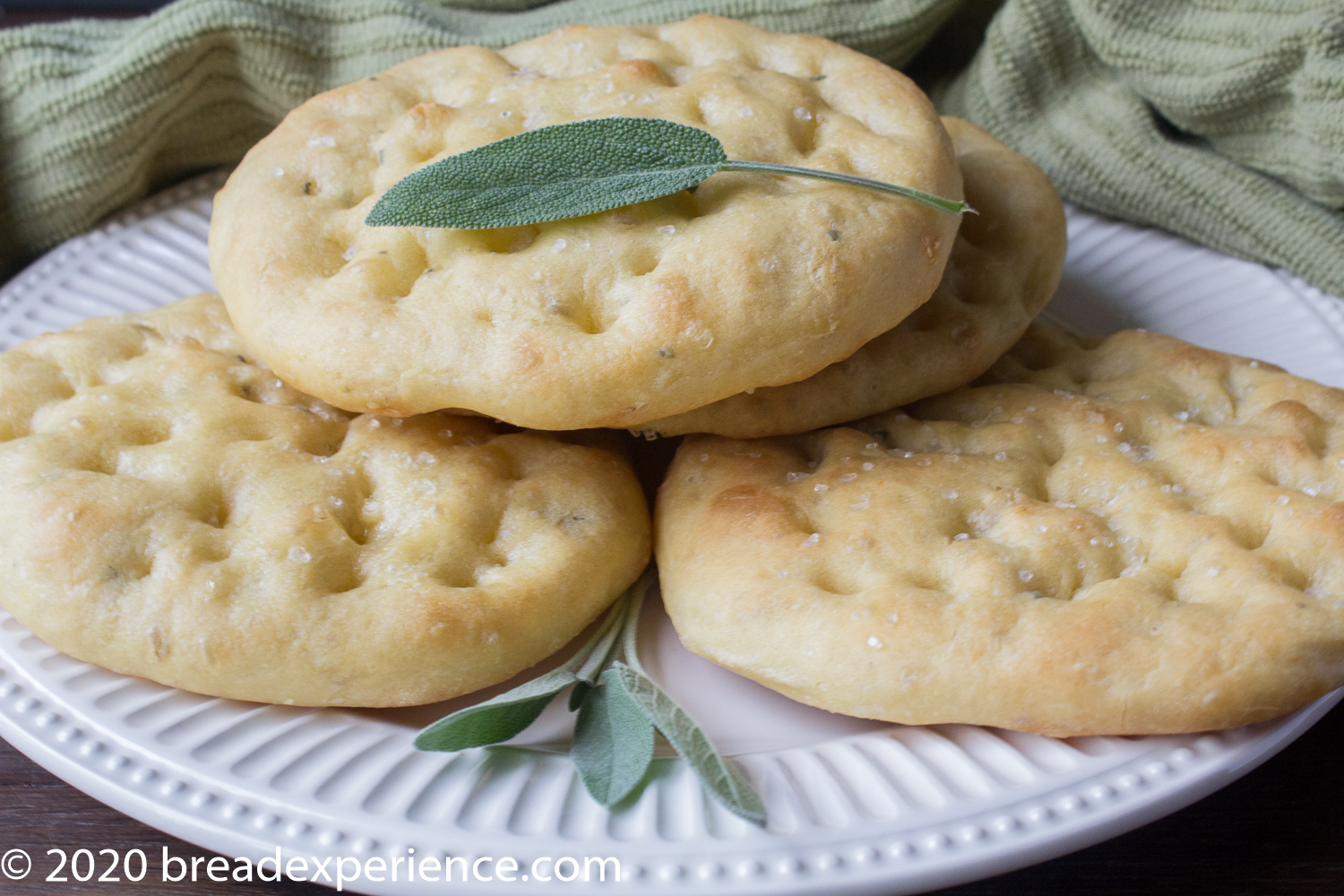
Typically, focaccine are made with Italian Type 0 flour or a blend of Type 0 and durum wheat flour. Type 0 is made from soft wheat, and apparently, it is similar to the all-purpose flour we get here in the States. I almost used a blend of regular all-purpose and durum wheat flour until I remembered how soft all-purpose einkorn flour is.
Einkorn has a higher protein content than regular wheat, but because it is soft, with a buttery color and silky texture, I thought it would do well in this bread. I was right! The dough was a dream to work with.
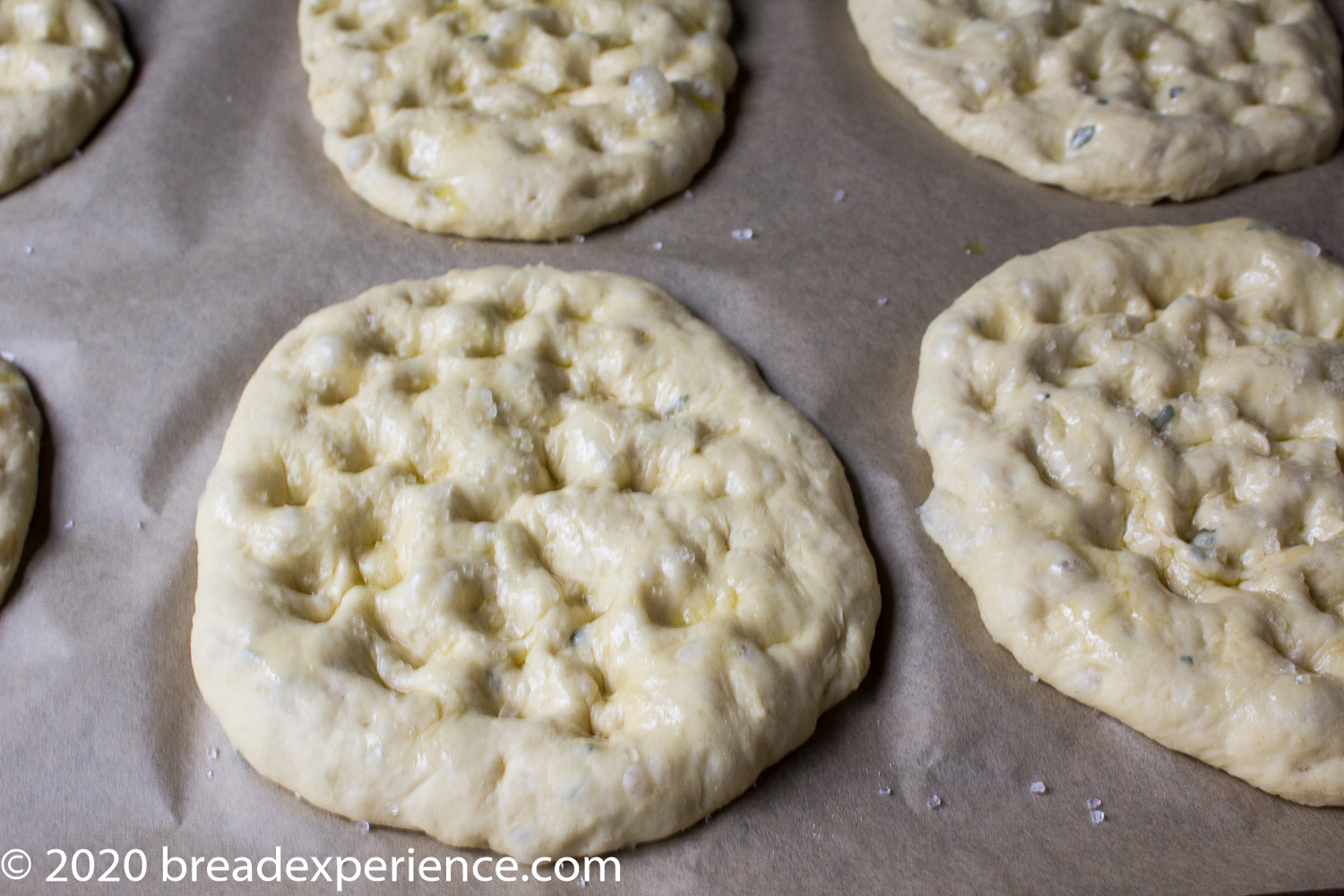
Pat of Feeding my Enthusiasms is the kitchen of the month for the Bread Baking Babes, and she chose these snacking breads as the monthly bake. She found these delicious treats on the blog My Pinch of Italy.
Potato focaccine are unique flatbreads due to the size and the inclusion of potatoes, which add softness to the dough. According to Fiorenza of My Pinch of Italy, adding potatoes to the dough is not unusual in Italian baking, especially in the South of Italy. Who knew?
Focaccine is usually flavored with rosemary and thyme, which would’ve been my first choice as well, but I liked the idea of using sage, especially since I have some growing in my garden and don’t always get the opportunity to use it in bread.
I couldn’t taste the sage in these breads so I think either the amount called for in the original recipe, 7-8 sage leaves, was not enough or I chopped them too small. If you are going to dip the breads in olive oil and herbs like I did, you won’t need any additional sage. However, I think I’ll add more next time anyway.
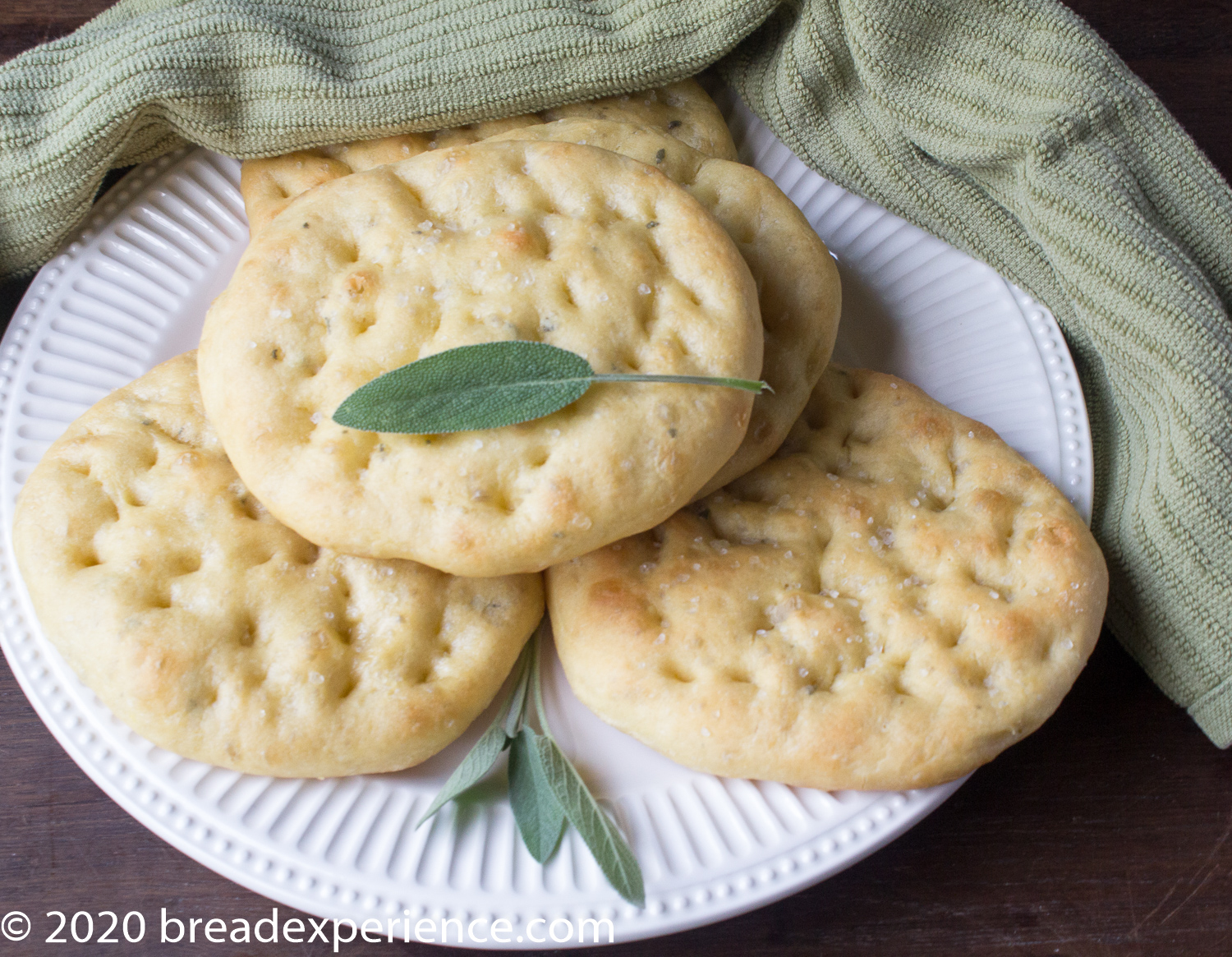
The original instructions said to roll it out with your hands (not with a rolling pin), and then form discs of about 1 centimeter with a pastry cutter or with an upside-down glass.
Instead of rolling out the dough, I divided the dough into ten pieces (80 grams each) and spread each piece out with my fingers like you do with focaccia. This method worked well for me. The focaccine are small but not too small. If you want to make them even smaller for snacking, just divide the dough into smaller pieces.
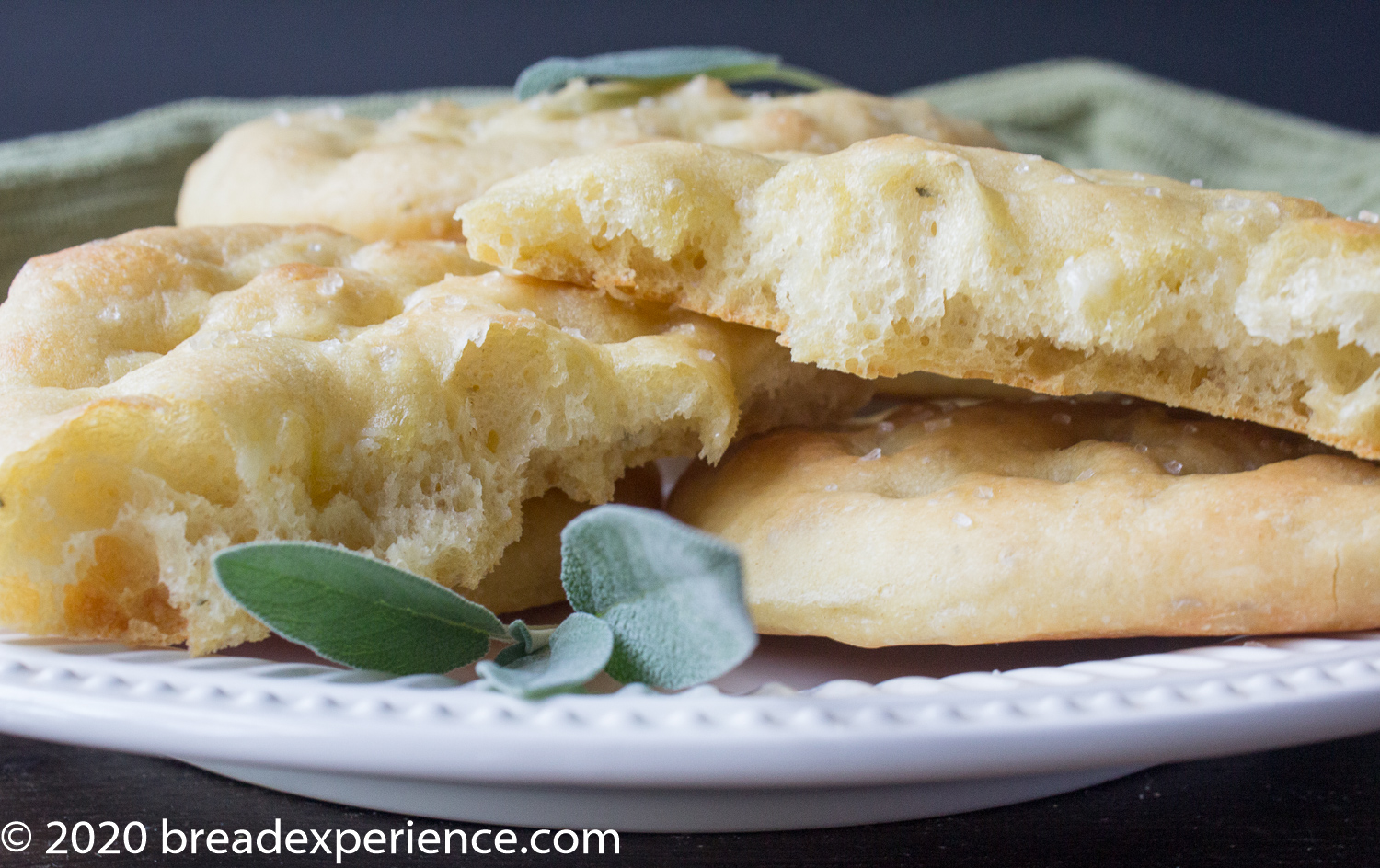
I baked the first batch of (6) focaccine longer than the second batch so the ones in the first batch were a little crunchier. They reminded me of big crackers. I enjoyed the big crackers, but I also enjoyed the softer ones which were more like focaccia.

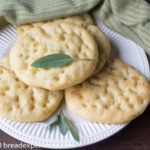
Einkorn Potato Focaccine Makes Great Snacking Bread
- Total Time: 3 hours 25 mins
- Yield: 10-12 Focaccine 1x
Description
These Einkorn Potato Focaccine, made with potatoes and all-purpose einkorn flour, are flavored with olive oil, sea salt, and sage. They look like little focaccia and are perfect for snacking.
Ingredients
- 150 grams yellow or white mealy potatoes, peeled (I used a russet potato)
- 400 grams all-purpose einkorn flour
- 6 grams (1 tsp) of fine sea salt
- 6 grams (1 1/2 tsp) instant yeast
- 40 grams (3 Tbsp.) extra virgin olive oil
- 200–225 grams (200 ml) Lukewarm water
- 1 Tbsp. 7-8 fresh sage leaves, to chop, more if desired
- Coarse sea salt, to taste
Instructions
- Boil the potatoes in salted or unsalted water. (I used salted water and it didn’t make the bread too salty. In fact, I thought it helped.)
- While the potatoes are boiling, chop the sage leaves with a knife or scissors.
- Once the potatoes are soft, remove from the heat, drain (reserving the water) and let them cool, slightly.
- Weigh/measure the potato water in a separate container. Mash the lukewarm potatoes with a potato masher, and mix with the reserved water. Creating a puree makes it easier to incorporate the potato into the dough. (I had about 85 grams of potato water so I mixed all of it with the mashed potato)
- In a large bowl, stir together the flour, salt, yeast, and freshly chopped sage.
- Add the potato puree to the flour mixture and mix with a wooden spoon until thoroughly incorporated.
- Pour in the olive oil and begin kneading with your hands. Add the rest of the water and knead well for 10 minutes until you get a soft and moist dough that will be a bit sticky. I added an additional 140 grams of water. (Although einkorn typically doesn’t absorb water like regular flour, the dough for these Focaccine seem to need the extra hydration.)
- Cover the bowl with plastic wrap, kitchen towel or bees wrap and let it rise for at least 2 hours in a warm and dry place. (My dough was ready after an hour. Although I reduced the amount of yeast, I could’ve reduced it to 1 tsp instead of 1 ½ tsp.)
- When the dough is doubled, place it on a lightly-floured work surface. Divide into 10 or more pieces.
- Roll each piece into a ball, then flatten using your fingers. Stretch it out by dimpling it and using extra olive roll. Using the tip of your fingers helps to create the characteristic dimples that allow the olive oil to collect in little puddles.
- Place the focaccine on a parchment-lined baking tray and let them rest for another 30 minutes. After the final proof, add more olive oil and dimple again using your fingers. (I used 2 baking sheets – placing 6 focaccine on one sheet and 4 on the other.)
- Bake at 180 ° C (160 C fan) (350 F) for about 20-25 minutes, depending on your oven. Rotate partway through the bake cycle for even baking.
- Remove from the oven and drizzle with additional olive oil and sea salt or dip a piece in olive oil infused with herbs.
Notes
Storing the focaccine – These Potato Focaccine are best eaten on the day they are made, but you can store them in a paper bag for a day. They also taste good toasted.
- Prep Time: 3 hours
- Cook Time: 25 mins
- Category: Focaccine
- Cuisine: Italian
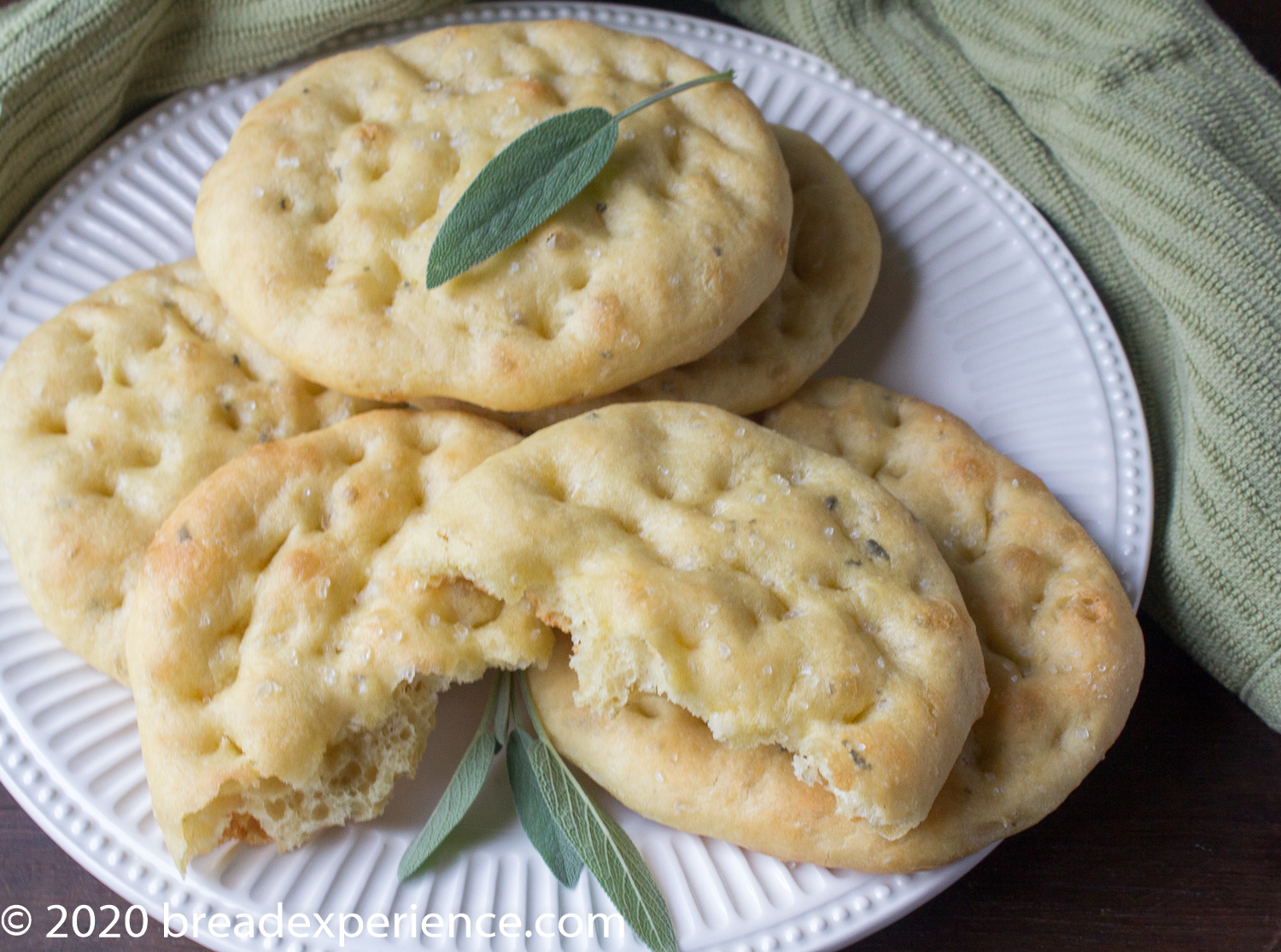
Who are the Bread Baking Babes?
We are a group of bread bakers who get together every month and bake bread! We have a Facebook group if you’d like to bake along. New recipes are posted every month on the 16th.
Pat (Feeding my Enthusiasms) is the host kitchen this month. Check out her blog post for more details on how to participate in this month’s challenge.
For more inspiration, check out these posts:
- Feeding my Enthusiasms – Pat (Host Kitchen)
- A Messy Kitchen – Kelly
- Karen’s Kitchen Stories – Karen
- Bread Experience – Cathy
- blog from OUR kitchen– Elizabeth
- My Kitchen in Half Cups – Tanna
- Judy’s Gross Eats – Judy
- My Diverse Kitchen – Aparna
- Thyme for Cooking – Katie (roundup)
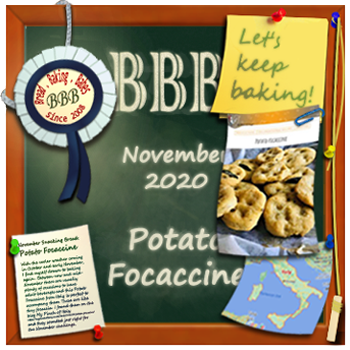
Happy Baking!
Cathy
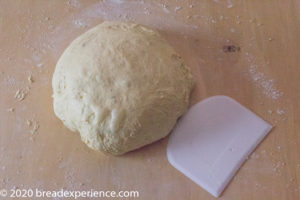
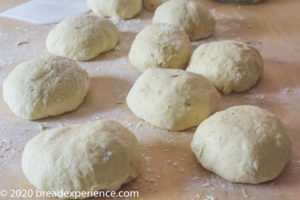
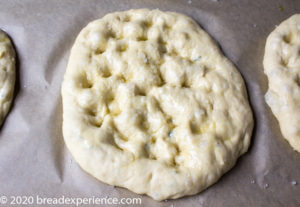
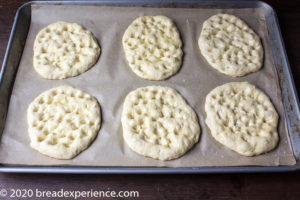
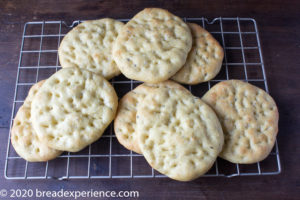
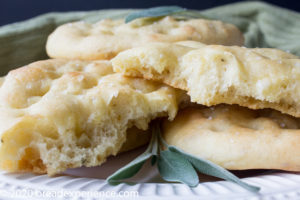
Karen says
Yours look perfect Cathy! You are so creative with different flours.
Cathy says
Thanks Karen! I really enjoyed the einkorn.
Kelly says
Those look amazing! Perfect little mini focaccia/focaccine. And look at that beautiful dough with the 100% einkorn, wow!
Cathy says
Thanks Kelly! The einkorn dough was a dream to work with.
Elizabeth says
Your Einkorn focaccine are beautiful! Oooh!! You dipped them in olive oil. Now THAT’s a good idea.
Cathy says
Thanks Elizabeth! They tasted great dipped in the olive oil and spices.
Tanna says
Gorgeous! LOVE the einkorn so my next batch will be with einkorn (I’m lucky I still have some). I may do a little of durum with the einkorn.
Great idea to infuse the olive oil with sage. I used about 12 leaves and got a mild pleasant sage in the breads but in the oil would have been lovely.
Cathy says
I think the durum and einkorn combination would be great! I almost did that but decided to stick with einkorn only. I’ll have to try 12 sage leaves next time. A mild sage flavor would be nice.
Katie Zeller says
I’m definitely going to try these…. I have lots of sage. They would be perfect to take on our bike rides.
Cathy says
Yes, they would be perfect for bike rides. Lots of sage, yes.
Aparna Balasubramanian says
These are so, so pretty! I did the same thing of dividing the dough into 12 and pressing them out. I couldn’t quite wrap my head around 1cm sized bread. 😀
Cathy says
Thank you Aparna! Ha ha! I know what you mean.